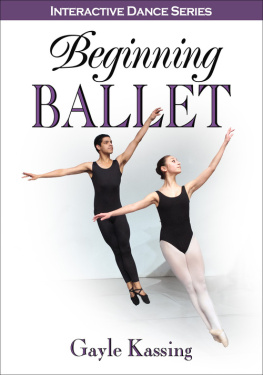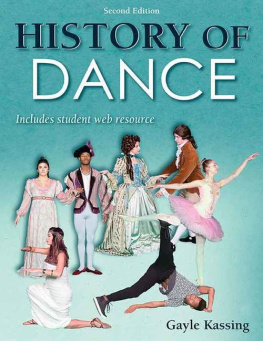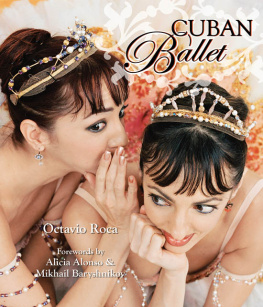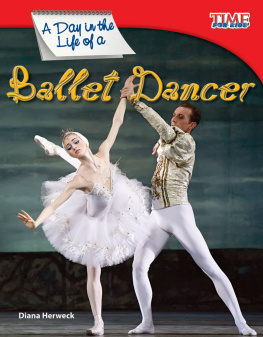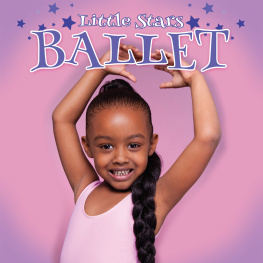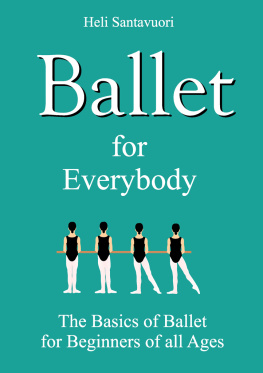Gayle Kassing - Beginning ballet
Here you can read online Gayle Kassing - Beginning ballet full text of the book (entire story) in english for free. Download pdf and epub, get meaning, cover and reviews about this ebook. City: Champaign, IL, year: 2013, publisher: Human Kinetics, genre: Religion. Description of the work, (preface) as well as reviews are available. Best literature library LitArk.com created for fans of good reading and offers a wide selection of genres:
Romance novel
Science fiction
Adventure
Detective
Science
History
Home and family
Prose
Art
Politics
Computer
Non-fiction
Religion
Business
Children
Humor
Choose a favorite category and find really read worthwhile books. Enjoy immersion in the world of imagination, feel the emotions of the characters or learn something new for yourself, make an fascinating discovery.
- Book:Beginning ballet
- Author:
- Publisher:Human Kinetics
- Genre:
- Year:2013
- City:Champaign, IL
- Rating:4 / 5
- Favourites:Add to favourites
- Your mark:
- 80
- 1
- 2
- 3
- 4
- 5
Beginning ballet: summary, description and annotation
We offer to read an annotation, description, summary or preface (depends on what the author of the book "Beginning ballet" wrote himself). If you haven't found the necessary information about the book — write in the comments, we will try to find it.
Beginning ballet — read online for free the complete book (whole text) full work
Below is the text of the book, divided by pages. System saving the place of the last page read, allows you to conveniently read the book "Beginning ballet" online for free, without having to search again every time where you left off. Put a bookmark, and you can go to the page where you finished reading at any time.
Font size:
Interval:
Bookmark:
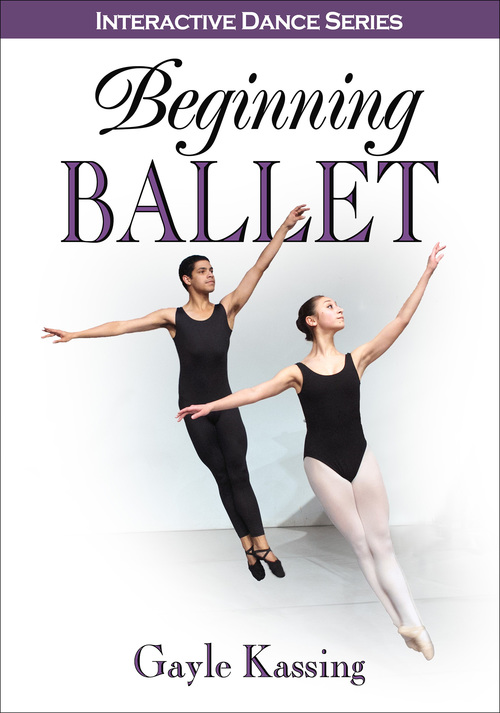
Library of Congress Cataloging-in-Publication Data
Kassing, Gayle.
Beginning ballet / Gayle Kassing.
p. cm. -- (Interactive dance series)
Includes bibliographical references and index.
1. Ballet--Handbooks, manuals, etc. I. Title.
GV1787.K285 2013
792.8--dc23
2012022050ISBN-10: 1-4504-0249-6 (print)
ISBN-13: 978-1-4504-0249-1 (print)
Copyright 2013 by Human Kinetics, Inc.
All rights reserved. Except for use in a review, the reproduction or utilization of this work in any form or by any electronic, mechanical, or other means, now known or hereafter invented, including xerography, photocopying, and recording, and in any information storage and retrieval system, is forbidden without the written permission of the publisher.
The web addresses cited in this text were current as of January 22, 2013, unless otherwise noted.
Acquisitions Editor: Scott Wikgren
Developmental Editor: Bethany J. Bentley
Assistant Editor: Derek Campbell
Copyeditor: Joanna Hatzopoulos Portman
Indexer: Sharon Duffy
Permissions Manager: Dalene Reeder
Graphic Designer: Joe Buck
Graphic Artist: Kathleen Boudreau-Fuoss
Cover Designer: Keith Blomberg
Photographer (interior and cover): Bernard Wolff, unless otherwise noted; photo on p. 138 Jose Luis Villegas/Sacramento Bee/ZUMA Press
Photo Asset Manager: Laura Fitch
Visual Production Assistant: Joyce Brumfield
Photo Production Manager: Jason Allen
Art Manager: Kelly Hendren
Associate Art Manager: Alan L. Wilborn
Illustrations: Human Kinetics
Printer: Versa Press
We thank Parkland Theatre in Champaign, Illinois, for assistance in providing the location for the photo shoot for this book. We also thank Twist and Shout Dance and Cheer in Mahomet, Illinois, for providing equipment for the photo shoot.
Printed in the United States of America
10 9 8 7 6 5 4 3 2 1
The paper in this book is certified under a sustainable forestry program.
Human Kinetics
Website: www.HumanKinetics.com
United States: Human Kinetics
P.O. Box 5076
Champaign, IL 61825-5076
800-747-4457
e-mail: humank@hkusa.com
Canada: Human Kinetics
475 Devonshire Road Unit 100
Windsor, ON N8Y 2L5
800-465-7301 (in Canada only)
e-mail: info@hkcanada.com
Europe: Human Kinetics
107 Bradford Road
Stanningley
Leeds LS28 6AT, United Kingdom
+44 (0) 113 255 5665
e-mail: hk@hkeurope.com
Australia: Human Kinetics
57A Price Avenue
Lower Mitcham, South Australia 5062
08 8372 0999
e-mail: info@hkaustralia.com
New Zealand: Human Kinetics
P.O. Box 80
Torrens Park, South Australia 5062
0800 222 062
e-mail: info@hknewzealand.com
E5318
Ballet began as a source of amusement for royalty. Today it has evolved into a source of delight for children, an alternative form of training for athletes and performing artists, and a passion for millions of dancers and spectators. Ballet instruction for all ages and interest levels has proliferated through community dance studios and arts programs, professional training schools, and high school and higher education courses.
A beginning ballet class requires both physical and mental participation. In courses such as English literature or Western civilization, you sit in class, listen to the teacher, take notes, work on projects, read the text, prepare outside assignments for class, and take tests. In ballet class, the teacher presents a series of exercises and combinations, and then you execute them. Throughout the class, you mentally take notes to learn the sequence of movements that comprise an exercise or combination. The teacher gives feedback on how to sharpen or refine your performance, and you remember that feedback in order to apply it the next time you execute the movement.
In a single ballet class students practice a variety of exercises, steps, and combinations. Throughout a course, the number of exercises, steps, and combinations increases and they become more complicated and difficult. It is often a challenge to understand the elements and technique requirements of each exercise or step that is presented in only one part of a class. Beyond learning the sequence of movements of an exercise or step, you must recognize and execute it and all its parts, then connect it to its French name. Compounding this situation, you must comprehend how these exercises, positions, poses, steps, and combinations relate to each other as part of beginning ballet technique. To alleviate confusion, you need both written and visual resources to support learning ballet technique and about ballet as an art form.
Beginning Ballet is a comprehensive book for students enrolled in a high school or college beginning ballet course. It may be taught in a fine arts, physical education, or dance program as either a general education course or an introductory course for dance majors or minors. The book prepares you for participating mentally and physically in a beginning ballet class. It presents the fundamentals of ballet technique and movement principles, introduces barre exercises and center steps, and provides a concise history of ballet artists and significant ballets to support you as an audience member. Learning ballet and learning about ballet are the first steps in understanding and appreciating it as a form of movement and as a performing art.
Chapter 1 introduces you to ballet as an art form and to the structure of the ballet class. It covers the changing ballet traditions and how ballet has proliferated in community and academic settings that afford you options if you wish to continue your ballet studies. Chapter 2 prepares you for taking ballet class, selecting proper dance wear and shoes for class, understanding expectations of participants, and class etiquette. Chapter 3 addresses dance safety, basic anatomy, injury prevention, and awareness of proper nutrition and hydration. Chapter 4 explains basic foot and arm positions, classical body positions, and poses of ballet. Chapter 5 describes principles of movement in ballet, how music supports the dance, and structure and design of basic ballet exercises and combinations. It provides strategies for learning ballet technique and preparing for performance testing in class. Chapter 6 illustrates the exercises that you study at the barre. Chapter 7 explores beginning ballet steps learned in the center part of class. In chapters 6 and 7 sequential photos illustrate the key positions in each exercise. Chapter 8 gives a brief historical survey of ballet, focusing on prominent world contributors, styles, and prominent works. The chapter provides strategies for viewing and reporting on ballet performances, which contribute to developing aesthetic values about ballet as a performing art.
The book contains a glossary of beginning ballet terminology, sidebars, and special elements such as self-check activities and historical tidbits to extend your ballet learning.
The web resource that accompanies this book offers supplemental, interactive instruction. Visit www.HumanKinetics.com/BeginningBallet1E to check it out. This resource provides you with added opportunities to practice the dance steps explained in this book.
When you participate in a ballet class, you join a tradition shared by all ballet dancers worldwide. Participating in beginning ballet can help you to
- develop new movement and dance skills and strengths,
Font size:
Interval:
Bookmark:
Similar books «Beginning ballet»
Look at similar books to Beginning ballet. We have selected literature similar in name and meaning in the hope of providing readers with more options to find new, interesting, not yet read works.
Discussion, reviews of the book Beginning ballet and just readers' own opinions. Leave your comments, write what you think about the work, its meaning or the main characters. Specify what exactly you liked and what you didn't like, and why you think so.

